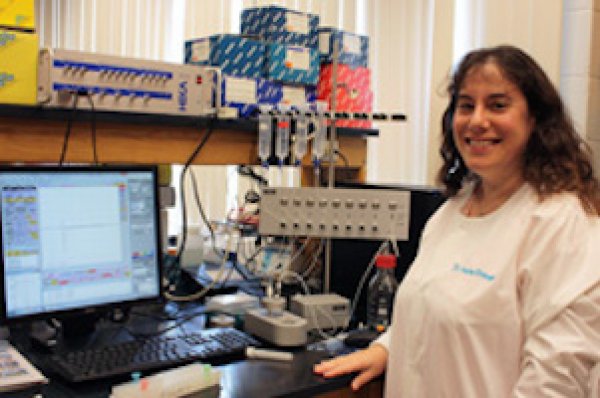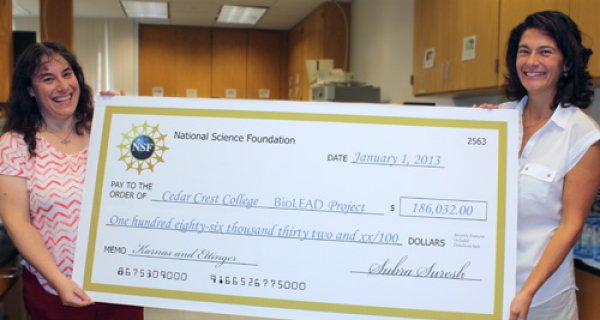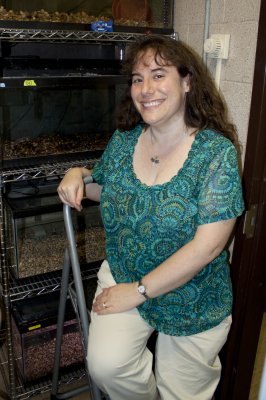Media
Publications:
Documents:
Videos:
Audio/Podcasts:
Biography
Audrey Ettinger is an Associate Professor of Biology at Cedar Crest College. She is also Director of the Neuroscience Program and the Health Professions Advisor. Her research interests include the use of herbal remedies to prevent damage from stroke; the effects of chemicals on fetal development; adult stem cells in the cichlid fish brain; the hormonal control of aggressive behavior, sex-specific behavior, and the development of behavior in a cichlid fish model.
Industry Expertise (3)
Research
Training and Development
Education/Learning
Areas of Expertise (12)
Neuroscience
Stem Cells
Women in Science
Developmental Biology
Nervous System Diseases
Bioethics
Herbal Remedies
Health Professions
Science Outreach to the Public
Fish Behaviour Observation
Molecular Biology
Cell Culture
Education (3)
Bryn Mawr College: A.B., Chemistry and Psychology 1992
Washington University School of Medicine in St. Louis: Ph.D., Neuroscience 1998
Stanford University: NRSA Postdoctoral Fellowship, Neuroscience 2002
Affiliations (6)
- American Society for Cell Biology (ASCB)
- Association of Biology Laboratory Educators (ABLE)
- Faculty for Undergraduate Neuroscience (FUN)
- Lehigh Valley Chapter of the Society for Neuroscience
- Pennsylvania Academy of Sciences (PAS)
- Society for Neuroscience (SFN)
Media Appearances (3)
Port-a-Patch in Education - Promotes Intriguing Neuroscience Research for Undergrad Students at Cedar Crest College
Nanion online
2013-10-17
The Port-a-Patch is often referred to as the world’s smallest patch clamp set-up. It is so small that it can be held in one hand, and at the same time a very powerful and enabling technology with a vast experimental freedom. Port-a-Patch makes patch clamping easier and offers about a tenfold throughput increase compared with the conventional set up. The learning curve is steep, thus allowing patch clamp also in shorter projects. Dr. Audrey Ettinger, Director of the Neuroscience Program at Cedar Crest College, has recently invested in a Port-a-Patch for teaching and for neuroscience research projects, intending to investigate the effect of herbal substances as neuroprotective agents in diseases such as stroke. Dissociated neurons from developing chick will be used as model in this study.

Ettinger and Reese: Eliminate barriers to science and math jobs for women
The Morning Call print
2013-10-14
The New York Times Sunday Magazine of Oct. 6 featured a lengthy discussion on the topic of "Why Are There Still So Few Women in Science?" The thoughtful content of the article was not a surprise to us as women scientists. We continue to be frustrated by the idea held by some that if women simply try hard enough, they will be successful, and that the lack of women in high positions in both academic and industrial science is somehow due to our own lack of interest in or aptitude for science.

Postdoc Trail: Long and Filled With Pitfalls
The New York Times print
2001-08-21
When Dr. Michael Dugan took his first postdoctoral research appointment in 1985, he considered it a steppingstone to a permanent theoretical physics post on a college faculty. But after three years at the University of California at Berkeley, the postdoctoral stints went on and on: two years at the Massachusetts Institute of Technology, four years at Harvard and one year at Boston University. While he was a finalist for a faculty job a few times, he never managed to be the one left standing when the music stopped.

Articles (5)
ε-Sarcoglycan Replaces α-Sarcoglycan in Smooth Muscle to Form a Unique Dystrophin-Glycoprotein Complex
The Journal of Biological Chemistry
1999-01-01
The sarcoglycan complex has been well characterized in striated muscle, and defects in its components are associated with muscular dystrophy and cardiomyopathy. Here, we have characterized the smooth muscle sarcoglycan complex. By examination of embryonic muscle lineages and biochemical fractionation studies, we demonstrated that ε-sarcoglycan is an integral component of the smooth muscle sarcoglycan complex along with β- and δ-sarcoglycan...
Progressive Muscular Dystrophy in α-Sarcoglycan–deficient Mice
JCB
1998-01-01
Limb-girdle muscular dystrophy type 2D (LGMD 2D) is an autosomal recessive disorder caused by mutations in the α-sarcoglycan gene. To determine how α-sarcoglycan deficiency leads to muscle fiber degeneration, we generated and analyzed α-sarcoglycan– deficient mice. Sgca-null mice developed progressive muscular dystrophy and, in contrast to other animal models for muscular dystrophy, showed ongoing muscle necrosis with age, a hallmark of the human disease...
ε-Sarcoglycan, a Broadly Expressed Homologue of the Gene Mutated in Limb-Girdle Muscular Dystrophy 2D
The Journal of Biological Chemistry
1997-01-01
The sarcoglycans are transmembrane components of the dystrophin-glycoprotein complex, which links the cytoskeleton to the extracellular matrix in adult muscle fibers. Mutations in all four known sarcoglycan genes (α, β, γ, and δ) have been found in humans with limb-girdle muscular dystrophy...
A synaptic localization domain in the synaptic cleft protein laminin beta 2 (s-laminin)
Science
1995-01-01
The basal lamina that ensheaths skeletal muscle fibers traverses the synaptic cleft at the neuromuscular junction. Synaptic and extrasynaptic portions of the basal lamina contain different laminin beta chains: beta 2 (or s) at synapses and beta 1 (or B1) extrasynaptically. Laminin beta 2 is also confined to synapselike patches on myotube surfaces in vitro, whereas beta 1 is present throughout the extracellular matrix...
A Cross-Curricular Molecular Genetics Lab in Embryology
Tested Studies for Laboratory Teaching: Proceedings of the Association for Biology Laboratory Education
2012-01-01
In response to the need for additional interdisciplinary, research-based labs that facilitate student learning across the biology curriculum, a student research project was developed as collaboration between Developmental Biology and Molecular Genetics courses to examine the effect teratogens have on a developing embryo, using both qualitative macroscopic observations and quantitative study of differential gene expression using microarrays. While the entire lab works as a multi-week unit to illustrate experimental design, technical methodology, and data analysis, component activities could be used as independent lab exercises in a variety of lab courses including molecular genetics, developmental biology, neuroscience, and introductory biology.






Social